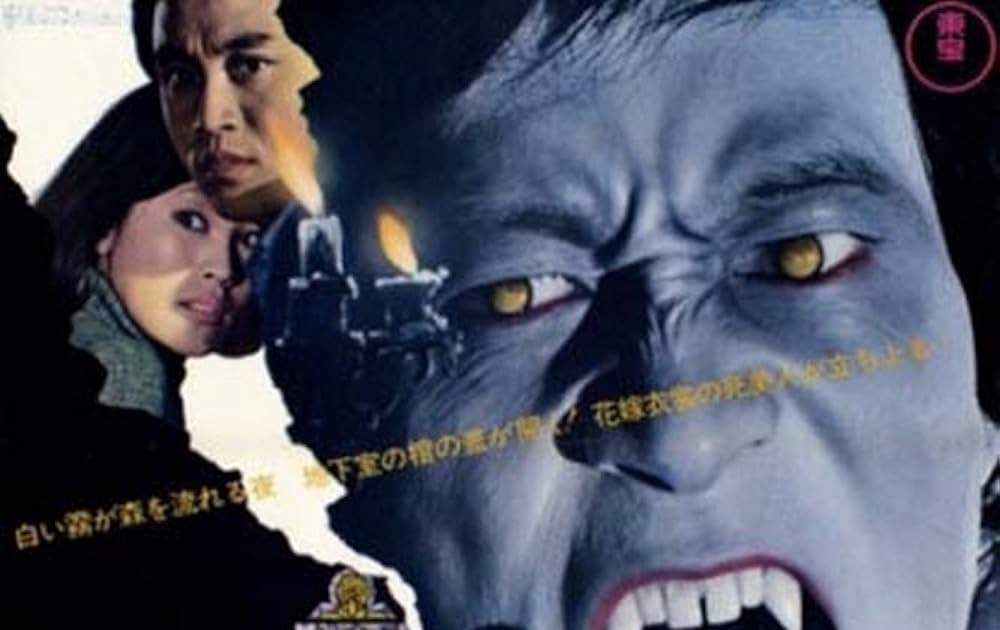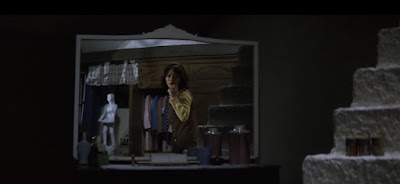The Japanese vampire movie Lake of Dracula, released in 1971, is the second movie in what became known as the Bloodthirsty Trilogy. It is not a true trilogy but it does comprise three gothic horror movies made in quick succession by the same director (Michio Yamamoto) for the same studio (Toho) and all dealing with vampires. They’re three entirely separate movies with no direct links to each other.
It begins with a little girl having a dream in which she loses her dog. At least she (and the audience) assume it’s a dream. It’s not really a very terrifying dream, although perhaps she doesn’t remember the terrifying parts. We then jump forward a number of years. The girl, Akiko (Midori Fujita), is now a young woman living with her younger sister Natsuko (Sanae Emi). They live in a cottage on the shores of Lake Fujimi. Akiko has a boyfriend, a young doctor Takashi Saeki (Chôei Takahashi). He’s a really nice guy. Both girls are very likeable girl. We care about them. They’re typical cheerful bubbly young women.
Akiko cannot forget the dream. It has driven her to produce a disturbing painting of a hideous eye.
A large crate has just been delivered to Akiko’s neighbour’s house. The crate contains a coffin. The neighbour’s servant Kyûsaku is unwise enough to open the coffin.
Akiko by now has another dog and it runs off just as did the dog in the dream. It runs off into the woods, and while Akiko is searching for it Kyûsaku tries to rape her. This is very surprising. Kyûsaku is a very gentle soul.
Another young woman is found near the lake. She is barely alive and has lost a lot of blood. She has puncture wounds on her neck. Dr Takashi Saeki has slim hopes of saving her.
Akiko becomes increasingly frightened. She has seen a strange man hanging around the neighbour’s house. There were the incidents in the woods wth the dog and with Kyûsaku. And Natsuko is behaving rather strangely.
There’s no mystery that there is a vampire abroad and Akiko and her boyfriend eventually figure that out.
The plot doesn’t hold many surprises but atmosphere is what matters in gothic horror and this film has a nicely spooky atmosphere that is achieved in a nicely low-key way. The vampiric transformations are handled well. When someone is vampirised they don’t look much different, in fact most people would not notice anything strange about them other than the fact that they look rather pale. The main clues lie in slight changes in behaviour.
Sanae Emi handles this very expertly. She plays Natsuko as a normal cheerful very likeable young woman and as a vampire she is subtly menacing and seductive in an unsettling way.
This is very much a western vampire story in a Japanese setting. And yes, Dracula himself does play a part albeit indirectly.
It’s not a particularly terrifying movie but I’ve never thought that gothic horror movies were supposed to be terrifying. Or at least they’re not supposed to trade in straightforward physical terror. They’re about the dread of the unnatural, the dread of evil. In a thriller or a slasher movie we’re afraid that the hero or heroine will be killed. In a vampire or a werewolf film we’re worried that he or she will be transformed into a thing of evil. It’s the fear of eternal damnation rather than death. To some extent that’s true of witchcraft movies as well. The witch might not just kill you. She might curse you for all time, and curse your descendants.
From around 1970 to 1972 was an interesting period for the vampire film. In various countries filmmakers were all coming up with the same idea – to revitalise the genre by moving the vampire into contemporary setting. In France there was Jean Rollin’s The Nude Vampire (1970), in Spain there was Jesus Franco’s film Vampyros Lesbos (1970), in Britain Hammer’s Dracula A.D. 1972 (1972), in the U.S. Count Yorga, Vampire (1970) and The Velvet Vampire (1971). It’s intriguing to find that the Japanese were working along the same lines at the exact same time.
Lake of Dracula is enjoyable if you don’t set your expectations too high. Recommended.
Arrow’s Blu-Ray presentation is excellent. I’ve also reviewed the first film in this trilogy, The Vampire Doll (1970). It’s rather more interesting than Lake of Dracula.




